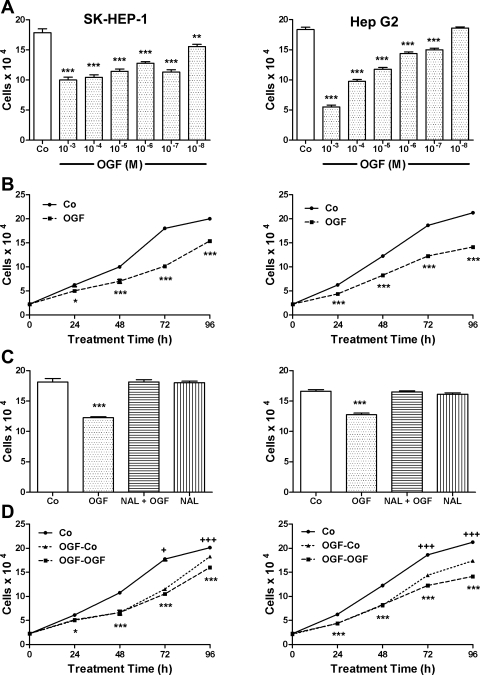Fig. 2.
OGF inhibits growth of human HCC cells in a dose-dependent, temporal, receptor-mediated, and reversible manner. A: growth of SK-HEP-1 and Hep G2 cells subjected to various concentrations of OGF for 72 h. OGF or an equivalent volume of sterile water [control (Co)] was added 24 h after seeding 100,000 cells/well, and media and OGF were replaced daily. B: growth of SK-HEP-1 and Hep G2 cells treated with OGF (10−6 M) or an equivalent volume of sterile water over a 96-h period. OGF or water (Co) was added 24 h (0 h) after cells were seeded at 100,000 cells/well; media and OGF were changed daily. C: opioid receptor mediation of the growth inhibitory effects of OGF in SK-HEP-1 and Hep G2 cells. Cell cultures were subjected to OGF (10−6 M), the opioid antagonist naloxone (Nal; 10−8 M), Nal + OGF, or sterile water (Co) for 72 h. Cells were seeded at 100,000 cells/well, and media and compounds were replaced daily. D: reversibility of the growth-inhibitory effects on SK-HEP-1 and Hep G2 cells treated with 10−6 M OGF or sterile water (Co). Cells were seeded at 100,000 into 6-well plates and treated with OGF or sterile water for 48 h; cells were counted at 0, 24, 48, 72, and 96 h. At 48 h, one-half of the culture plates continued to receive OGF for an additional 48 h, and one-half of the plates were treated with sterile water for 48 h. Control cultures received sterile water throughout the 96 h. Compounds and media were replaced daily. For all experiments, data represent means ± SE for at least 2 aliquots/well from at least 2 wells/group. Data significantly different from respective controls: *P < 0.05, **P < 0.01, ***P < 0.001. OGF-Co group significantly different from OGF-OGF group: +P < 0.05; +++P < 0.01.

